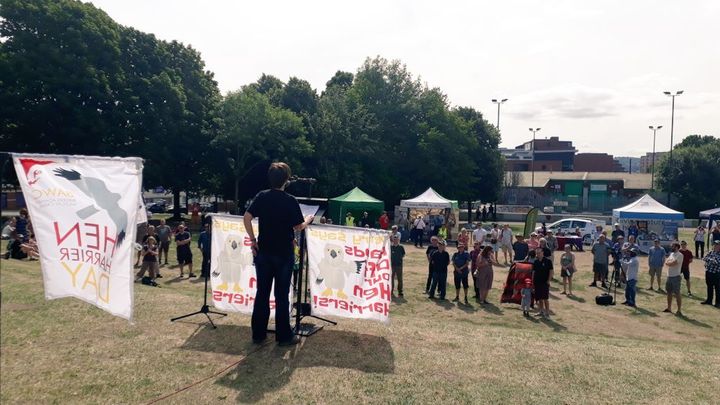
This year’s Sheffield’s Hen Harrier Day had a very different feel to 12 months ago. Last year, there was gloom and anger. This year there was still anger, but also a tiny glimmer of hope – and the feeling that campaigning over years has just started to pay off.
I expect that to carry into other Hen Harrier Days around the country this coming weekend, when the nation comes together to celebrate these magnificent birds of prey and demand more are allowed to survive and thrive.
The tone in Sheffield was because, for the first time in years in the Peak District, the city’s lungs and playground, this year a pair of hen harriers had maintained a nest, with four chicks successfully fledged (and tagged so their progress can be monitored). Once that nest was found it was carefully watched and protected, mostly by volunteers, many of whom were at the Sheffield event and happy to share their delight at the experience of watching the dedicated work of the parents for their young.
The success was widely seen as a result of action by the National Trust, which after a great deal of local and national campaigning, removed a tenant managing land for driven grouse shooting from the area. The Peak nest was part of a very modest improvement for hen harriers around England – from three successful breeding pairs last year to nine this.
That had to be put, however, as Liz Ballard of the Sheffield and Rotherham Wildlife Trust did on Saturday, in the context of where we should be. It is estimated there’s habitat for 300 breeding pairs of hen harriers in England; 290 are missing – and at the current rate of progress we won’t reach that until 2068.
None of the successful nests were on private grouse moors. And as another speaker pointed out, there wasn’t one successful nest in the whole of the giant county of Yorkshire, which should be prime territory for these magnificent birds. There’s no doubt that’s connected to another way in which Yorkshire, particularly North Yorkshire, stands out – as a hotspot for “raptor persecution”.
Killing, destruction of nests, any other disturbance to any bird of prey, is illegal. That’s helped with a significant recovery of many species – indeed the Sheffield crowd got to enjoy a buzzard soaring overhead, circling as if it were checking on proceedings. But hen harriers have the misfortune that their prime habitat and nesting sites corresponds closely to land managed for driven grouse shooting – land managed so that grouse numbers can reach up to 100 times the natural level.
And the hen harriers eat young grouse. As do the foxes, crows and ravens, stoats and weasels that are slaughtered in massive numbers on the grouse moors to stop them doing that. Even the innocent, beautiful mountain hares, which carry a tick that might transmit a grouse disease, are slaughtered en masse. All of that other slaughter is, astonishingly legal, but the illegality of the act doesn’t stop the slaughter of the hen harriers and other raptors or the destruction of their nests.
But it is getting harder and harder for the shooting industry to get away with this. Campaigners have ensured that the public is increasingly aware of the slaughter on the uplands. Campaigning pressure forced Labour-run Bradford Council – the last local authority in the UK to allow grouse shooting on public moorland - to end driven grouse shooting on Ilkley Moor.
And brave, determined groups are documenting at close quarters the illegal activities on the moors. Technological advances mean hidden cameras can be placed to expose the abuses. Sometimes people are able to hide close enough to video what happens in these isolated places. Groups like the Hunt Investigation Team have, at considerable personal discomfort and some risk, exposed what was previously hidden.
And crucially, more and more of the chicks that do live to fledging in England, Scotland and Wales are being tagged with satellite trackers that mean we know their fate. Young hen harriers do have a naturally high mortality rate. The RSPB tracking programme has found about 40% dying naturally in their first two years out of the nest.
But that tracking programme has been so successful and informative because the satellite-linked tags fitted to the birds continue transmitting after their death, and can usually be recovered – in one case recovered, still working, after 10 days immersion in the sea.
So this is a time of year to celebrate the success of campaigns, the progress of public understanding about the damage being done by the slaughter of driven grouse shooting.
But there’s a long way to go. This is an activity built on illegality, and also on generating costs that the rest of us pay – for the management of the land for driven grouse shooting reduces the capacity of the moorland to absorb rainfall and so help prevent or reduce flooding. And it reduces crucial carbon storage on our uplands.
More Hen Harrier Days are coming up this weekend – I’ll be at Rainham Marshes in Essex and at Stratford-upon-Avon for the Midlands event on the Inglorious Twelfth (the day on which the driven grouse shooting season starts), and there are also gatherings in the Highlands, Northern Ireland and Cheshire. The pressure on the driven grouse shooting industry just keeps growing.
